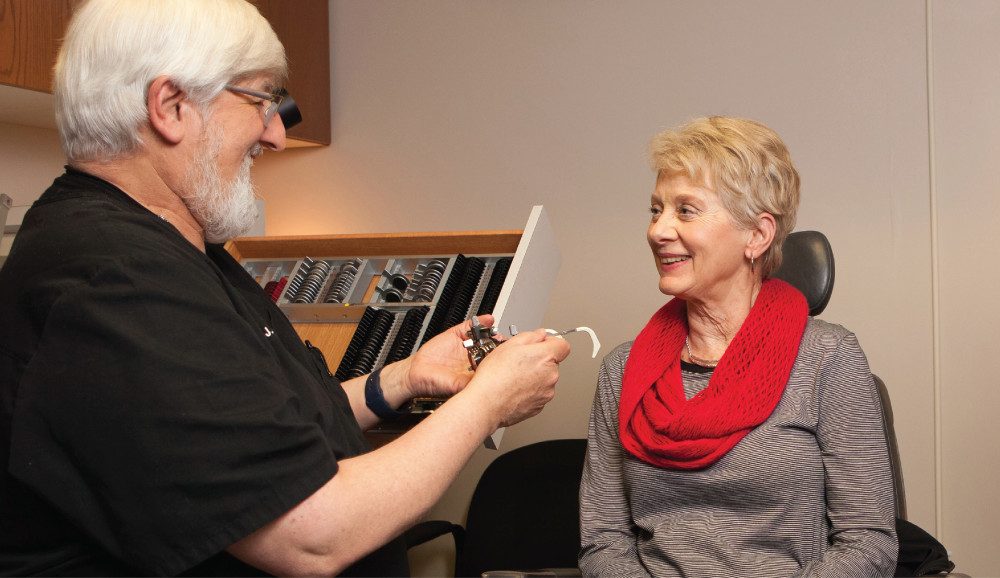There are many conditions and diseases that can affect the eyes and your vision. Here are some of the more common eye conditions we treat here at The Eye Center:
Glaucoma
Glaucoma is a very common disorder that damages the optic nerve, which is the part of the nervous system that sends visual information from your eye to your brain. Glaucoma may not have symptoms until damage has already been done, and many people who have glaucoma don’t realize it until it’s too late.
This is why glaucoma testing needs to be a regular part of your eye exam, and one of the reasons it’s so important to have regular eye exams.
Diabetic Eye Diseases
People who suffer from diabetes are more likely to have glaucoma, cataracts, and some other eye disorders. One of the eye diseases that is most commonly seen along with diabetes is diabetic retinopathy.
Diabetic retinopathy damages the blood vessels in the eyes, starting with swelling and continuing to the point where blood vessels are blocked and the eye begins to make new blood vessels. Unfortunately, the new blood vessels are shallow and fragile, and they can begin to bleed. This interferes with vision and can even lead to blindness.
Lifestyle choices can help to prevent or manage diabetic retinopathy. There are also some treatments that can help even in later stages of the disorder.
Strabismus (Lazy Eye)
Having two eyes that focus on objects from very slightly different angles allows us to see the world in three dimensions. When the eyes can’t align correctly and the result of the two angles would be double vision instead of 3-D vision, the brain adapts to the situation by suppressing the information from one of the eyes. The result can be limited vision and eyes that appear to look in different directions.
Strabismus is most often diagnosed in children, but a stroke or other medical conditions can bring the condition on in adults as well. Treatments include therapy for the muscles of the eyes and for the connection between the brain and the eye.
Retinal Disorders
The retina senses light and sends images to the brain. There are a number of disorders of the retina that can affect vision, including diabetic retinopathy (described above) and macular degeneration, an age-related condition leading to the loss of central vision. High blood pressure can also damage the retina. The wide range of possible disorders of the retina are one reason that regular eye exams are so important.
Retinal detachment, where the retina is pulled away from the back of the eye, should be considered a medical emergency. Repair is possible if the condition is caught early.
Refractive Errors
Sharp vision depends on the shape of the eye. If the shape of the eye is not perfect for the process of getting images to the brain, nearsightedness and farsightedness will be the result. Presbyopia, difficulty focusing in near distance, is another common type of refractive error. Many people find that they can no longer read or do close work as they get older.
Astigmatism is another category of refractive error. A normal eye is shaped like a basketball. If the cornea is shaped more like a football, the result can be eyestrain, squinting, blurred vision, or headaches.
Refractive errors are not diseases or disorders, but they are the main reason for heading for the eye doctor. Glasses and contact lenses are the most common way of coping with refractive errors. The Eye Center has all the optical solutions you need.

Corneal Disease
The cornea is the clear outer layer of the eye. It protects the inner parts of the eye and is a big part of our ability to focus. Allergies, injuries, and infections can all affect the cornea.
Conjunctivitis
Also known as “pink eye,” conjunctivitis is an inflammation of the eye. It can be contagious, and it is usually very uncomfortable, leading to itching and burning of the eyes. While it usually clears up on its own, treatment may be needed. If conjunctivitis continues over the long term, it can lead to damage of the cornea and loss of vision.
Corneal Dystrophy
A build-up of cloudy material on the cornea can interfere with vision. Often this condition is inherited, and it does not seem to be affected by lifestyle choices such as diet or exercise, nor are they related to other health issues. Corneal dystrophy can occur in otherwise healthy people. They can be painful and impair vision, or they may show up in an eye exam before they have caused any problems at all. Regular eye exams can identify these and other vision problems early.
Fuch’s Dystrophy
Fuch’s Dystrophy is a condition in which the normal flow of liquid into and out of the eye is disrupted and the cornea can swell. This interferes with normal vision and may eventually require a corneal transplant. One of the early signs of Fuch’s Dystrophy is blurry vision in the morning from fluids that have built up during sleep; over a period of years or decades this can develop into blurry vision throughout the day. Regular eye exams can catch this disorder early and allow treatment during the early stages.
Ocular Herpes
The same viruses that cause chickenpox and cold sores can also cause eye infections. These viruses can be present in the body for years without causing any symptoms. Sometimes a health condition that affects the immune system can cause the viruses to multiply, and the cornea is one of the areas where they can show up.
Ocular herpes brings pain, often in only one eye, redness and swelling, sensitivity to light, and sometimes cloudiness of the cornea.
